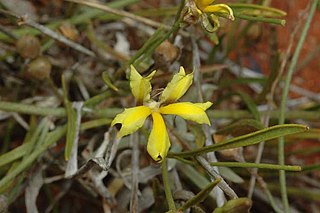
Isopogon dawsonii, commonly known as the Nepean conebush, is a shrub of the family Proteaceae and is endemic eastern to New South Wales. It has pinnate leaves with narrow segments and spherical heads of creamy yellow to greyish white flowers.

Eucalyptus populnea, commonly known as poplar box, bimble box or bimbil box, is a species of small to medium-sized tree that is endemic to eastern Australia. It has rough, fibrous or flaky bark on the trunk and branches, egg-shaped, elliptical or more or less round leaves, flower buds arranged in groups of seven to fifteen or more, white flowers and conical, hemispherical or cup-shaped fruit.

Corymbia ptychocarpa, commonly known as the swamp bloodwood or spring bloodwood, is a species of tree that is endemic to northwestern Australia. It has rough bark on the trunk and branches, broadly lance-shaped adult leaves, flower buds in groups of seven, creamy yellow, pink or red flowers, and barrel-shaped, ribbed fruit.
Persoonia brachystylis is a species of flowering plant in the family Proteaceae and is endemic to a restricted area on the west coast of Western Australia. It is an erect, spreading shrub with smooth bark, narrow spatula-shaped to lance-shaped leaves and yellow flowers in groups of ten to twenty.

Eremophila tietkensii is a flowering plant in the figwort family, Scrophulariaceae and is endemic to Australia. It is a rounded to flat-topped shrub with grey-green leaves, usually pinkish-purple sepals and mauve, pink or lilac-coloured petals. It is mostly found in Western Australia but also occurs in the far west of the Northern Territory.
Verticordia rennieana is a flowering plant in the myrtle family, Myrtaceae and is endemic to the south-west of Western Australia. It is an openly branched shrub with small, narrow, warty leaves and pink and silvery-white flowers in spring and summer.

Grevillea trachytheca, commonly known as vanilla grevillea or the rough-fruit grevillea is a shrub of the genus Grevillea native to an area in the Mid West and Gascoyne regions of Western Australia.

Ptilotus manglesii, commonly known as pom poms is a herb native to Western Australia. The Noongar name for the plant is mulla mulla.
Calytrix merrelliana is a species of plant in the myrtle family Myrtaceae that is endemic to Western Australia.
Calytrix watsonii is a species of plant in the myrtle family Myrtaceae that is endemic to Western Australia.

Isopogon crithmifolius is a species of plant in the family Proteaceae and is endemic to the south-west of Western Australia. It is a shrub with divided leaves and more or less spherical heads of glabrous reddish pink flowers.

Boronia adamsiana, commonly known as Barbalin boronia, is a plant in the citrus family, Rutaceae and is endemic to a small area in the south-west of Western Australia. It is an erect, hairy shrub with trifoliate leaves and pink or white, four-petalled flowers.

Ptilotus pyramidatus, the pyramid mulla mulla, is a small white herb in the family Amaranthaceae.

Ptilotus polystachyus is a grass-like plant in the Amaranthaceae family.

Ptilotus auriculifolius is a grass-like plant in the Amaranthaceae family.

Coopernookia strophiolata is a shrub in the Goodeniaceae family, endemic to Australia and found in both Western Australia and South Australia.

Goodenia fascicularis, commonly known as silky goodenia, is a species of flowering plant in the family Goodeniaceae and is widely distributed in eastern continental Australia. It is an ascending perennial herb with linear to egg-shaped leaves and racemes of yellow flowers.
Teucrium grandiusculum is a species of flowering plant in the family Lamiaceae and is endemic to central Australia. It is a perennial herb or shrub with toothed, egg-shaped leaves and white flowers.

Ptilotus humilis is an annual herb in the Amaranthaceae family, native to Western Australia. It was first described as Trichinium humile by Nees von Esenbeck in 1845 but was transferred to the genus, Ptilotus, by Ferdinand von Mueller in 1868.
Gompholobium simplicifolium is a species of flowering plant in the pea family Fabaceae and is endemic arid part of Western Australia and the Northern Territory. It is an erect or spreading shrub with cylindrical leaves and orange-yellow, pea-like flowers.















